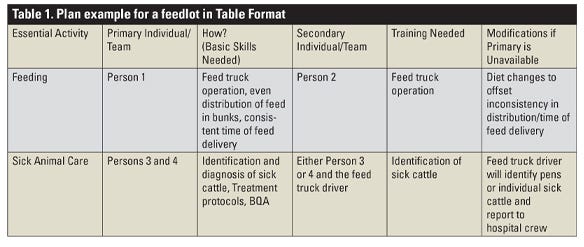April 21, 2020

Not only is continuity of business important for farmers and ranchers during the COVID-19 pandemic, but food production also has been classified as essential and should continue.
Continuing production in a pandemic situation requires that people in agriculture carefully consider how COVID-19 infections may affect the operations in which they work. As plans to continue business are made, remember these details about COVID-19 transmission:
COVID-19 is spread mainly between people who are in close contact (within about 6 feet).
The virus is believed to be spread through contact with droplets made when an infected person coughs, sneezes or talks. The virus may live airborne for a period of time.
COVID-19 can live on surfaces such as plastic, stainless steel and cardboard for an extended period of time (24-plus hours).
COVID-19 may be spread by people who are not showing symptoms.
Related: Complete coronavirus coverage
To protect yourself and others, the Centers for Disease Control and Prevention (CDC) has established guidelines that include:
Staying home when possible. If you must go out, avoid close contact and maintain at least 6 feet of distance between people.
Practicing good hand hygiene, including frequent washing and sanitizing.
Avoiding touching of the face, eyes, nose and mouth.
Cough and sneeze into your elbow or a tissue, then immediately wash your hands.
Covering your mouth and nose with a cloth face cover when around others.
Limiting transmission is critical to protect people who are at higher risk for getting sick from COVID-19 (ages 65 or older or people with underlying health conditions). Everyone must minimize their risk of becoming infected while also working to prevent the spread of the virus to others.
Using this information, transmission risk can be reduced during essential operations and help ensure continuity.
The following are guidelines and recommendations that can be used to implement COVID-19 control in agricultural systems.
Stay informed. Follow federal, state and local direction to reduce personal risk for contracting COVID-19 and to limit further transmission if you or your employees become infected. Stay informed at cdc.gov/coronavirus.

Make a plan. Make a written plan (See Table 1 for example): What are the essential activities of the operation (feeding, farm work, etc.)? Who is primarily responsible for completing those activities? How those activities are accomplished? (What basic skills are needed for the activity?) Who is available to complete those tasks if the primary individual becomes unavailable? How may essential activities have to be modified if primary individuals are unavailable?
Write down the plan in as much detail as possible and make team members aware of the plan to ensure continuity of business if COVID-19 infections begin to have a direct effect that disrupts normal management channels.
Consider worst-case scenarios for this situation (e.g., all team members are in quarantine because of exposure) and how essential operations can continue (e.g., asymptomatic team members self-quarantine at the operation to continue operations) and the logistics required for that plan.

Separate duties. Develop plans to separate the teams, family members or hired personnel to prevent transmission.
Separate duties and use personal distancing of employees while at work and not at work. Examples: processing livestock, filling planters, brandings, etc.
Hold virtual meetings. Consider conducting employee meetings virtually on Zoom, FaceTime or other programs. If meeting in-person, follow CDC guidelines.
Clean high-touch areas. Limit use of common areas — use only with social distancing and hygiene guidelines going into and coming out of high-touch areas, such as meeting rooms, common kitchens, common restrooms, sinks and refrigerators, etc.
Clean and disinfect high-touch areas frequently (see cleaning disinfection guidance). Bleach may be used to disinfect surfaces, but the concentration is higher for COVID-19 than for everyday sanitation: 5 tablespoons of bleach per gallon of water.
If bleach is difficult to obtain, a list of disinfectants effective against COVID-19 is available at epa.gov. Read and follow labels, including dilution rates and contact time.
Clean vehicles, tractors, implements and tools. Place hygiene supplies (hand sanitizer or disinfectant wipes) in equipment and other shared areas (e.g. shop). When changing operators — when entering and leaving or before and after use — disinfect hands using sanitizer, disinfectant all high-touch areas (e.g. steering wheel, control handles, door handles, syringes, etc.), consider disposable covers for porous surfaces such as seats and other upholstered surfaces, and allow for three-hour downtime to allow the virus to die in confined spaces (e.g. cabs), if possible.
For more information specific to trucks, see cdc.gov for applicable information.
Communicate with people coming to your location, such as consultants, veterinarians, dealers, mechanics, etc. Set up appointments that include time, meeting place and a plan for transmission control (social distancing, cleaning or disinfection, personal protective equipment, etc.).
Confirm that people are feeling well and have not traveled to high-risk locations before departure for visit.
Coordinate delivery of products and inputs, such as feed, medicine, supplements, pesticides. Develop noncontact delivery methods (e.g. drop-off locations), wash your hands after handling packaging, consider wearing gloves and consider disinfection of nonporous packaging.
For deliveries that require person-to-person interaction, develop physical reminders for social distancing (tape on floor, barriers, etc.) Practice hand sanitizing or washing before and after interaction.
Identify essential supplies and consider increasing inventory. Develop contingency plans if essential supplies become unavailable.
Vander Ley is a Nebraska Extension veterinary epidemiologist; Erickson is a Nebraska Extension beef feedlot nutrition specialist; and Rasby is associate dean of Nebraska Extension.
Source: UNL CropWatch, which is solely responsible for the information provided and is wholly owned by the source. Informa Business Media and all its subsidiaries are not responsible for any of the content contained in this information asset.
Read more about:
Covid 19You May Also Like




